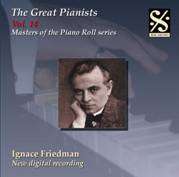|
Back
05/03/2011
Johann Sebastian Bach: Chromatic Fantasy and Fugue, BWV 903
Harold Bauer:Motley & Flourish – Barberini’s Minuet
Ludwig van Beethoven: Turkish March from The Ruins of Athens – Gavotte in F major
Fryderyk Chopin: Polonaise in C sharp minor, Op. 26 No. 1 – Etude in C sharp minor, Op. 25 No.7 – Piano Sonata No. 3 in B minor, Op. 58
Franz Liszt: Paganini Etude No. 2 in E flat major
Ignacy Jan Paderewski: Polonaises, Ops. 9 & 11
Harold Bauer (piano)
Recorded in 1992 from piano rolls made between 1916 and 1929 – 73’06
Dal Segno #DSPRCD 053 – Booklet in English

Johann Sebastian Bach: Toccata and Fugue in D minor, BWV 565
Fryderyk Chopin: Waltzes, Op. 18 & Op. 64 No. 1 ‘Minute’ – Impromptu in A flat major, Op. 29 – Polonaise in B flat major, Op. 71 No. 2
Ignace Friedman: Elle danse, Op. 10 No. 5 – Old Time Minuet, Op. 76 No. 6 – Viennese Dances Nos. 1-4
Franz Liszt: Paganini Etude No. 3 ‘La Campanella’ – Hungarian Rhapsody No. 14 in F minor
Moritz Mozskowski: Serenade, Op. 15
Anton Rubinstein: Romance in E flat major, Op. 44
Robert Schumann: Fantasiestücke: ‘Des Abends’ & ‘Warum’, Op. 12 No. 1 & 3
Richard Wagner: Magic Fire Music from Die Walküre
Ignace Friedman (piano)
Recorded in 1992 from piano rolls made between 1921 and 1929 – 73’33
Dal Segno #DSPRCD 054 – Booklet in English

The two CDs are part of Dal Segno’s ‘The Great Pianists – Masters of the Piano Roll’ series. First of all, one should bear in mind that the pieces recorded in these CDs are not actually ‘played’ by the pianists themselves, but by a perforated paper roll, the so-called piano roll. This automatic mechanism obtains musical sound by judicious use of expression controls, damper pedal control, tempo regulator, and, in some instances, printed instructions suggesting the dynamics, and thereby re-enacts the original touch and expression of the recording pianist. In other words, the recorded performances in this series of CDs are indeed ‘played’ by a self-playing piano instead of pianists themselves. One should therefore properly adjust to an aurally and aesthetically appropriate attitude before listening to the performances in these two releases.
The piano rolls used in these two discs were made mainly in the 1910s and 20s, before the technique was wiped out by the economic Depression and replaced by other more advanced recording techniques in the 1930s. Nonetheless, it preserves certain aspects of the performances of a great many notable late nineteenth and early twentieth-century musicians, including Leschetizky, Mahler, Saint-Saëns, Debussy, Ravel, and Busoni, among many others. Despite the fact that the recording technique could never genuinely reflect the actual performance per se, piano roll, which documents undeniably profound changes in performance practice, allows us both to actually hear something of how the early players sounded and to interpret performance style from the immediate pre-recording era more accurately.
Not only do the two releases document some of the two pianists’ most monumental performances, they also include their performances of their own compositions. The beguiling Motley & Flourish by Bauer is a miniature showing the pianist’s Baroque contrapuntal interest. The light-hearted Barberini’s Minuet, on the other hand, is full of musical sly and humor. What is most enchanting in the Bauer disc comes from his performances of Chopin. The improvisatory ebb and flow in the Polonaise and poetic insight in the Etude are the trademark ‘golden age’ elements that are of nowhere to be found in any modern pianist. The performance of Chopin’s Third Sonata is certainly the highlight of this CD. The enthralling lyricism and beauty in the first and third movements intertwined with the white-knuckle tension and a great sense of heroic fortitude in the last, making the Sonata a rhetorical and cohesive narrative.
Similarly, Chopin’s music takes a central role in Friedman’s disc. The polish pianist’s extemporaneous treatment to every musical detail and occasionally improvised accompaniments and embellishments, particularly in the ‘Minute’ Waltz, are telling exemplifications of the performance style of Romantic pianists. The two lesser-known works in the piano literature – Mozskowski’s Serenade and Anton Rubinstein’s Romance – are of no doubt master piano pieces that deserve the acquaintance of every piano music aficionado. The CD also encompasses a few pieces composed by Friedman himself. Like most early twentieth-century pianists, these miniatures, probably played as encores of a concert or in a salon function, serve the major purposes of entertaining the audience and showing off the pianist’s virtuosity. The six dances by Friedman included in this disc, though similar to the style of Liszt’s paraphrases, exhibit higher degree of originality than those by Bauer and sound remarkably pleasant and fluent to ears attuned to Romantic piano repertoire.
Despite the limitation of the piano roll in capturing every parameter of a performance, the two releases, particular the Friedman one which possesses a higher recording quality, are highly recommended to experienced listeners and piano music collectors who can possibly envisage the ‘missing parts’ with their aural imagination. They are also of immense value to professional musicians and musicologists in every sense.
Danny Kim-Nam Hui
|